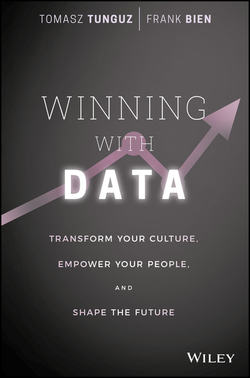Читать книгу Winning with Data - Bien Frank - Страница 5
На сайте Литреса книга снята с продажи.
Chapter 1
Mad Men to Math Men: The Power of the Data-Driven Culture
Operationalizing Data: Uber's Competitive Weapon
ОглавлениеWho among us does not say that data is the lifeblood of their company? The largest hoteling company [AirBnB] owns no hotel rooms. The largest taxi company [Uber] owns no taxis.
– Ash Ashutosh, CEO of Actifio
At their core, the best data-driven companies operationalize data. Instead of regarding data as a retrospective report card of a team's performance, data informs the actions of each employee every morning and every evening. From harnessing customer survey responses to evaluating loan applications, these Math Men and Women are transforming every industry and every function.
As Ash Ashutosh said, the biggest transportation and lodging companies own no infrastructure. Instead, they manage data better than anyone else. Just four years after Uber was founded, its San Francisco revenues totaled more than three times all the revenues of all the taxi cab companies in the city. Two years later, the Yellow Cab Cooperative, which has operated the largest fleet of taxis in San Francisco for decades, filed for bankruptcy.
Among many innovations, Uber brought data to the taxi industry. Using historical data, Uber advises drivers to be in certain hotspots during certain times of day to maximize their revenue because customers tell them with the push of a button where to be. Uber matches the closest driver with the customer to minimize wait time and maximize driver utilization and earnings.
In contrast, disconnected Yellow Cab drivers listen to a coffee-fueled, fast-talking dispatcher relaying telephone call requests by radio. Individual drivers claim passenger pickups by responding over the CB, even if they are the furthest cab from the customer. “How long until the taxi arrives?”
Dispatchers can handle only one request at a time, serially. In rush hour, potential passengers redial after hearing a busy tone. Let too much time elapse coming from the other side of town and your passenger has already jumped into an Uber. For the Yellow Cab driver, the gas, time, and effort are all wasted because of an information asymmetry. In comparison to Uber, Yellow Cab drivers are driving blind to the demand of the city, and Yellow Cab customers are blind to the supply of taxi cabs.
Uber changes its pricing as a function of demand, telling drivers when it makes sense to start and stop working. Surge pricing, though controversial, establishes a true market for taxi services. Yellow Cab drivers don't know the best hours to work and prices are fixed regardless of demand.
Data improves more than the marketplace efficiency. Uber employs drivers based on their customer satisfaction data provided by consumers. Drivers who score below a 4.4 on a 5.0 scale risk “deactivation” – inability to access Uber's passenger base. Meanwhile, the Yellow Cab company maintains an average Yelp review of less than 1.5 stars out of 5.
The data teams that optimize Uber driver locations, maximize revenue for drivers, and drive customer satisfaction operate on a different plane from the management of the Yellow Cab company. Blind, Yellow Cab drivers are completely outgunned in the competitive transportation market. They don't have what it takes to compete: data.
But the Uber phenomenon isn't just a revolution in the back office. It's also about a new generation of taxi drivers, who operate their own businesses in a radically different way. What cabbie in the 1990s could have dreamed that upon waking early in the morning, a mobile phone would suggest there's more money to be made in the financial district of San Francisco than at the airport? But the millennial driver knows the data is attainable: It's just a search query or text message away. This is the fundamental, secular discontinuity that data engenders.
